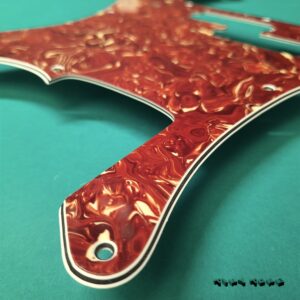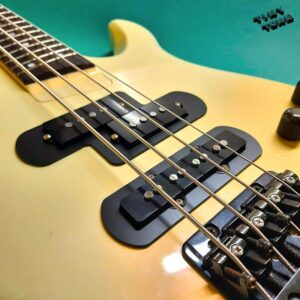The 3 different Bevel types
We offer different edge bevel options for your custom scratch plate and with many of our sheet materials, this is a chance to show off the ply layering!
Classic 45° edge


Roundover Edge Bevel


90° Edge Bevel


To get started with your custom ‘guard build
90 degrees
For mass-produced, solidbody guitars at least, it all started with the 90 degree version- just a simple right angle at the edge of the guard, no messing about and -literally- no frills. There are two main reasons to go for a 90 degree edge; either you have a vintage Fender and are going for that vintage aesthetic from the era when ol’ Leo was too cheap to bother chamfering the edges of either his bodies or his pickguards, or you’ve picked a material where any other type of edge dressing isn’t possible- such as any pickguard made from metal.
Classic 1950s Telecaster and ’51-style P-basses look amazing -and historically accurate- with either 1ply white or black bakelite guards for example. Metal material choices such as anodized gold can’t be chamfered however- issues with tooling aside it just never looks good, compared to 1 ply white which never looks bad with a 90 degree edge. Got one of those old Squier guitars or basses with a 1 ply scratchplate, which has a 45 degree edge and has faded to the colour of gone-off cream from the back of a student house’s fridge? Bung a 1-ply white guard on there with a 90 degree edge and marvel at how classy and vintage it now looks!
45 degrees
The logical step up from a 1-ply sheet material was multi-ply materials. Though prohibitively expensive for many companies at first, those that could afford them were keen to show the layers off, and what way to do that then bisecting the edges?! After all, it was much, much cheaper and easier to do this then to use binding techniques to craft a bound guard like on even more expensive models of the era.
The 1953 Gibson Les Paul custom is a great early example of a 5-ply pickguard with an angled edge. Of course, at risk of getting nerdy the early pickguards by all manufacturers were actually at a sharper angle then 45, often 30 degrees, with 45 only becoming standard in the mid-late 60s. We don’t offer 30 degrees as an option however as it throws up a world of hurt with pickguard size vs screw positioning.
Unless you’re Fender with their late-60s reissue of the Tele-Bass (which had a 3ply white guard, 90 degree bevel to save buying in a load of 1ply material), 45 degree edges work best with any layered material. Anything 3ply, 4ply or 5ply will always look best with a 45 edge, sure as night follows day.
Roundover
The third and final option, the compromise which only works in certain situations- an exception in exceptional circumstances. A roundover is literally a rounded-over top edge of the scratchplate, which takes the sharp edge off and allows for a pleasing curve. However, it’s a pretty bad idea on multi-ply guards usually- when viewed from above, you only see the top couple of layers. This means 3ply white becomes 2ply and just looks clunky; 5-ply looses all of its class… it might look different, and it might even look good, but ultimately you’re paying for layers you can’t see!
Where roundovers shine however is on acrylics and bakelite- thicker materials where a 45 isn’t possible, but where the thickness means a rounded-over edge is an essential feature to avoid the edges creating playing discomfort or just not looking good. Our favourite place for a roundover is definitely our ‘chrome mirror acrylic’- this can have polished edges too, giving the finished product an impossibly classy and bespoke appearance for a mere bit of reflective plastic.
So that’s a brief intro to our three edge options. I’ve outlined the rules… but then rules can sometimes be broken. If you have something in mind, talk to us and we’ll see what we can do!
Hopefully though, this will help you choose the right one for your guitar!







